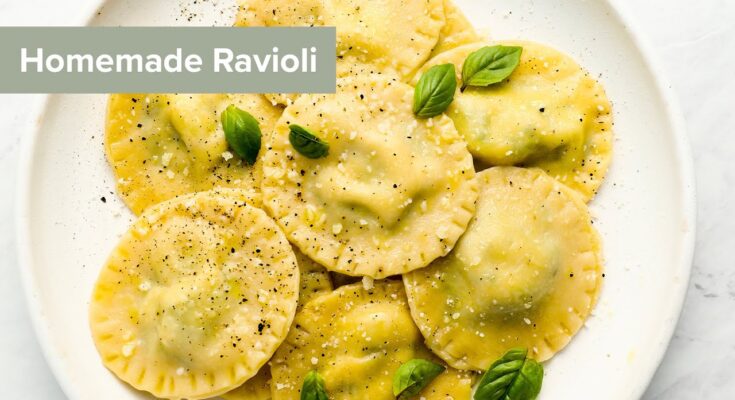Ravioli Recipe: Ravioli, those delightful little pockets of stuffed pasta, have been a favorite across Italian households for centuries. Whether filled with cheese, meat, or vegetables, ravioli offer an explosion of flavors in every bite. While they may seem intimidating to make from scratch, the process is surprisingly simple and incredibly rewarding.
Why make ravioli at home? The answer lies in customization. You can experiment with unique fillings, control the quality of ingredients, and avoid preservatives often found in store-bought options. Plus, there’s something truly magical about crafting each piece with your hands—an experience that brings both joy and a deep connection to the food you’re making.
This guide will take you step by step through the process, ensuring even beginners can craft perfect ravioli right in their kitchen. Ready to impress your family and friends? Let’s dive in!
Ingredients for Ravioli
For the Pasta Dough:
- 2 cups of all-purpose flour (plus extra for dusting).
- 3 large eggs.
- ½ teaspoon salt.
- 1 tablespoon olive oil (optional).
For the Filling:
- 1 cup ricotta cheese.
- ½ cup grated Parmesan cheese.
- 1 large egg yolk.
- ½ teaspoon salt.
- ¼ teaspoon black pepper.
- Optional: Fresh herbs (basil, parsley) or spinach for added flavor.
Optional Variations:
- Meat Lovers: Ground beef or Italian sausage cooked and mixed with ricotta.
- Vegetarian Delight: Spinach and feta cheese blend.
- Vegan Alternative: Cashew-based “ricotta” with nutritional yeast.
Having these ingredients on hand ensures a smooth cooking process. Remember, fresh and high-quality ingredients are the secret to truly exceptional ravioli.
Essential Tools You’ll Need
Making ravioli doesn’t require a professional kitchen setup, but a few key tools will make the process easier:
- A clean countertop or pasta board for rolling dough.
- Rolling pin or a pasta machine.
- Sharp knife or pastry cutter.
- Ravioli mold or stamp (optional).
- A fork for sealing edges.
- Large pot for boiling.
- Slotted spoon for serving.
Don’t have a ravioli mold? No problem! A simple glass or biscuit cutter can create uniform shapes. Just be sure to press the edges firmly to avoid any leaks during cooking.
Pro tip: Lightly dust your tools and surface with flour to prevent sticking. Trust us—it’s a lifesaver!
Preparing the Pasta Dough
The foundation of great ravioli lies in its dough. Here’s how to make it:
- Create a Flour Well: On a clean surface, pile your flour and make a well in the center. Crack the eggs into the well and add salt.
- Mix Gradually: Use a fork to whisk the eggs, slowly incorporating flour from the edges.
- Knead the Dough: Once the mixture forms a shaggy dough, knead it with your hands for about 10 minutes until smooth and elastic.
- Rest the Dough: Wrap the dough in plastic wrap and let it rest for 30 minutes at room temperature.
Resting the dough is crucial as it allows the gluten to relax, making it easier to roll out later. If it feels too dry, sprinkle a few drops of water. Too sticky? Dust with flour. Adjust as needed to achieve a firm but pliable texture.
Making the Ravioli Filling
For classic ricotta filling:
- Combine Ingredients: In a bowl, mix ricotta cheese, Parmesan, egg yolk, salt, and pepper.
- Add Flavors: Fold in chopped herbs or cooked spinach for a burst of freshness.
- Taste and Adjust: Always taste the filling before assembly—this ensures it’s perfectly seasoned.
Making meat or vegan fillings? Follow a similar process, adjusting ingredients to your preference. Store any leftover filling in the refrigerator for up to 3 days or freeze for future ravioli-making sessions.
Rolling Out the Dough
Rolling out pasta dough is where the magic begins. The goal is to achieve a thin, even sheet that allows the filling to shine without overpowering it. Here’s how to do it:
- Divide the Dough: After resting, cut the dough into smaller, manageable pieces. Keep the unused portions wrapped to prevent them from drying out.
- Flatten the Dough: Using a rolling pin or pasta machine, roll the dough into thin sheets. Aim for a thickness of about 1/16 inch or setting 6 on most pasta machines.
- Check for Transparency: Hold the dough sheet against the light. If you can see your hand through it, you’re good to go.
For beginners, rolling by hand might take a little extra effort, but it’s completely doable. Just ensure consistent pressure as you roll, turning the dough often to prevent sticking.
Pro tip: Dust your work surface and tools with a bit of flour, but don’t overdo it, as excess flour can make the dough tough.
Shaping and Filling Ravioli
Now comes the creative part—assembling your ravioli! Whether you prefer traditional square shapes or more unique designs, this step is all about precision.
- Lay Out the Dough: Place one sheet of dough on a floured surface. If using a ravioli mold, position it on top.
- Add the Filling: Spoon small dollops of filling (about 1 teaspoon each) onto the dough, leaving enough space between each one. Overfilling can cause the ravioli to burst during cooking.
- Cover with Another Sheet: Gently lay another sheet of dough over the filling, pressing down around each mound to remove air pockets.
- Seal the Edges: Use a fork to crimp the edges or a ravioli cutter for a decorative touch.
- Cut into Shapes: Cut your ravioli into squares, circles, or other shapes using a knife, cutter, or mold.
Air pockets are your enemy here! They can cause the ravioli to open up while cooking, so press firmly around the edges to create a tight seal.
Cooking the Ravioli
Cooking ravioli is quick and straightforward, but timing is everything. Follow these steps for perfectly cooked pasta:
- Boil Water: Bring a large pot of salted water to a gentle boil. The salt enhances the flavor of the pasta.
- Cook in Batches: Drop the ravioli into the water in small batches to avoid overcrowding.
- Watch for Floating: Fresh ravioli typically cook in 2-4 minutes. When they float to the surface, they’re done.
- Remove Carefully: Use a slotted spoon to lift the ravioli out of the water, allowing excess water to drain.
Avoid overcooking, as it can cause the ravioli to become mushy. If you’re making large batches, you can transfer cooked ravioli to a baking sheet lined with parchment paper to prevent sticking.
Serving Suggestions
Ravioli is incredibly versatile and pairs beautifully with a variety of sauces and sides. Here are some serving ideas to elevate your dish:
- Classic Tomato Sauce: A simple marinara made with fresh tomatoes, garlic, and basil.
- Creamy Alfredo: A rich and velvety sauce with Parmesan and cream.
- Brown Butter Sage: Melt butter until golden and add fresh sage leaves for a nutty, aromatic topping.
- Pesto: Bright and herby pesto adds a fresh, summery vibe.
Garnish your ravioli with freshly grated Parmesan cheese, a drizzle of olive oil, and a sprinkle of cracked black pepper. For sides, consider a crisp green salad or garlic bread to round out the meal.
Presentation matters too! Serve your ravioli on a warm plate, drizzle with sauce, and add a sprig of fresh herbs for an Instagram-worthy finish.
Ravioli Variations
Why stick to the basics when there’s a world of ravioli possibilities? Here are some fun variations to try:
Regional Variations:
- Ligurian Ravioli: Stuffed with a mix of Swiss chard and ricotta, served with walnut sauce.
- Pumpkin Ravioli: A Northern Italian favorite, often paired with butter and sage.
Creative Fillings:
- Mushroom Ravioli: Sautéed mushrooms blended with ricotta and Parmesan.
- Seafood Ravioli: Filled with crab or shrimp for a luxurious treat.
- Dessert Ravioli: Sweetened ricotta or mascarpone with chocolate chips and a dusting of powdered sugar.
Dietary Alternatives:
- Vegan Ravioli: Use plant-based ricotta made from cashews or tofu.
- Gluten-Free Ravioli: Substitute all-purpose flour with a gluten-free blend, adjusting liquid amounts as needed.
Experimenting with these variations keeps ravioli-making exciting and allows you to cater to different tastes and dietary preferences.
Tips for Making Perfect Ravioli
Making perfect ravioli takes practice, but a few tips can make the process smoother and your results more consistent:
- Prevent Stickiness: Always work on a lightly floured surface and dust your ravioli lightly to prevent sticking. Avoid over-flouring, as it can make the pasta tough.
- Avoid Overfilling: Use just enough filling to taste it in every bite without risking the ravioli bursting during cooking. A teaspoon per piece is usually ideal.
- Seal Properly: Air pockets are a common culprit behind exploding ravioli. Press firmly around the filling to remove any trapped air before sealing the edges.
- Use Fresh Ingredients: Fresh eggs, herbs, and high-quality cheese make all the difference in flavor and texture.
- Test a Single Ravioli: Cook one ravioli first to ensure the seal holds and the seasoning is on point before committing to the rest.
If you plan to freeze ravioli, lay them out on a baking sheet in a single layer and freeze until solid. Then, transfer to an airtight container or freezer bag. They’ll last for up to 2 months and can be cooked directly from frozen.
Nutritional Information
Ravioli can range from indulgent to relatively healthy depending on your filling and sauce choices. Here’s a breakdown of a standard cheese ravioli with marinara sauce:
- Calories per Serving (5 pieces): ~280 calories
- Protein: ~10g
- Carbohydrates: ~35g
- Fats: ~10g
- Fiber: ~2g
Want a healthier option? Use whole-wheat flour for the dough and swap out cheese fillings for roasted vegetables like sweet potatoes or butternut squash. Pair with a light tomato sauce or drizzle with olive oil and fresh herbs for a balanced meal.
FAQs about Ravioli Recipe
What’s the Best Flour for Ravioli?
The best flour for ravioli is all-purpose flour, but if you want silkier pasta, mix it with 00 flour. This Italian-style flour is finely milled and creates a softer, more delicate texture.
Can Ravioli Be Made Ahead of Time?
Yes! You can make ravioli ahead of time and refrigerate it for up to 24 hours before cooking. Be sure to dust them lightly with flour and store them in a single layer to prevent sticking.
How Do You Prevent Ravioli from Sticking Together?
Use a large pot with plenty of boiling water and gently stir the ravioli for the first minute of cooking. After boiling, toss the ravioli with a bit of olive oil if you’re not serving them immediately.
Can I Bake Ravioli Instead of Boiling It?
Absolutely! Layer the ravioli in a baking dish with your sauce of choice and bake at 375°F (190°C) for 20-25 minutes. Top with cheese for a bubbly, golden crust.
What’s the Best Sauce for Ravioli?
The best sauce depends on your filling. Cheese ravioli pairs well with marinara or Alfredo, while mushroom or spinach fillings are delicious with brown butter sage sauce.
Conclusion
Making ravioli at home might seem like a daunting task at first, but with this step-by-step guide, it’s an achievable and rewarding culinary adventure. From mixing the dough to crafting the perfect filling, each step offers a chance to connect with the art of cooking. Whether you stick with classic cheese and ricotta or venture into creative variations, homemade ravioli promises a dish full of love and flavor.
So, what are you waiting for? Dust off your rolling pin, gather your ingredients, and roll up your sleeves. Your perfect plate of ravioli is just a few steps away. Bon appétit!



